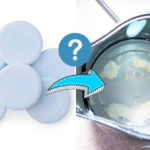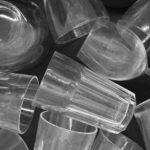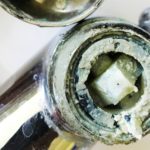If you live in a hard water area, it is likely that at some point you will have to deal with a limescale build-up on a shower door, window, mirrors or any other glass surfaces.
For many people, dealing with a limescale build-up on any surface is a dreaded chore, but it is possible to deal with the problem quickly and easily, and without any harsh chemicals.
How to Remove Limescale from Glass
If you have noticed that there is a build-up of limescale on your shower door, window, or other glass surfaces, you’ll be glad to know that it is possible to deal with the problem quickly, and it doesn’t necessarily require harsh chemicals either.
White vinegar and water solution

White vinegar is a great way to bring the shine back to a surface covered in limescale. Mix up a solution of half water, half white vinegar, and spray it onto the surface.
Let the solution sit for a few minutes before wiping it away and buffing the surface with a dry cloth. If the limescale is particularly stubborn, you might find that you need to use the rough side of a non-scratch scouring pad and a little elbow grease.
If it is all you have access to, there is no reason that this method would not work with brown malt vinegar, but the smell might just leave your home smelling like your local takeaway.
White vinegar and bicarbonate of soda
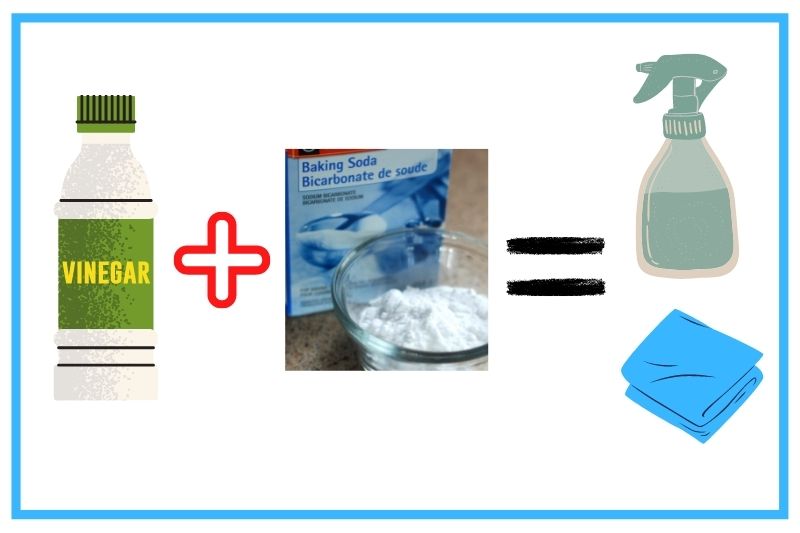
Another way to use white vinegar to deal with limescale is to heat it up. If you decide to try this method, make sure that you protect your hands and skin to avoid burns.
First, bring a cup of white vinegar to a boil either on the hob or in the microwave. Set the vinegar down on a stable surface in arms reach of the limescale build-up and allow it to cool slightly.
Wearing rubber gloves, dip clean paper towels into the vinegar and lay them on the glass over the limescale. The acid in the vinegar will soak into the mineral deposits and loosen them.
Let the vinegar sit for 30 to 60 minutes and spray them with vinegar from time to time to make sure the towels stay wet.
After 30 to 60 minutes, remove the paper towels and sprinkle a generous amount of bicarbonate of soda (baking soda) onto a damp cloth or sponge. The bicarbonate of soda will react with the vinegar, giving you a touch of extra cleaning power.
Wipe the shower door down gently and rinse the area with water to remove all traces of the vinegar and baking soda. If limescale remains, scrub the area again with baking soda until all the mineral deposits have been removed.
Bicarbonate of soda
Many homes will have bicarbonate of soda tucked away in the back of a cupboard, and this is one of those cleaning tasks where it is a great, natural cleaning agent. If you don’t have any, it’s easy to buy online.
Bicarbonate of soda has a natural abrasive quality and so is ideal for dealing with a limescale build-up.
Using a damp cloth, rub a small amount of powder on to the limescale, leave it for a couple of minutes, and then wipe away with a clean damp cloth before buffing the surface with a dry one.
Toothpaste
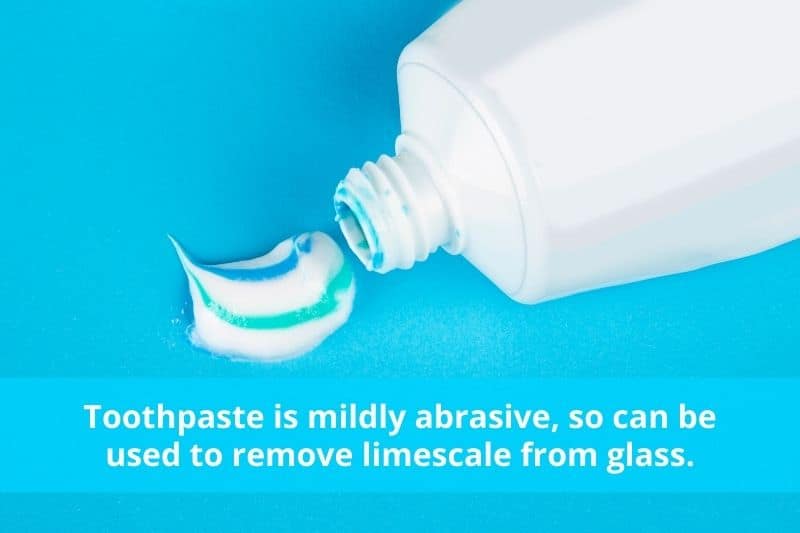
One method of dealing with limescale build-up that some people report as successful is to use toothpaste.
Scrub toothpaste onto the surface using either a sponge or an old, soft toothbrush, and leave it for a few minutes. Rinse the paste away, and buff the area with a clean, dry cloth.
We recommend using cheap toothpaste for cleaning purposes – you don’t want to be using up all of your fancy whitening or sensitive toothpaste on the shower screen.
WD-40
You may have a can of WD-40 laying around for when your door handle or hinge starts creaking (if you don’t, you can pick one up on Amazon here), but you probably haven’t considered using it to break down limescale before.
One of the things that WD-40 was designed to do is tackle residue, and so it can help you to cut through limescale on glass.
Simply spray the affected area, rub the stains, and wipe over the area with a clean microfibre cloth.
How to Prevent Limescale
Preventatives are often better than a cure. There are a range of ways to prevent limescale build-up, some easier (and more affordable) than others.
Hardwater treatment
If you have the budget to do so and it can be done in your home, you could consider installing a water softener.
With a water softener installed, the water that flows from your tap or showerhead will not have quite so many minerals in it, and so the limescale will take much longer to build up.
Preventative vinegar spray
If you cannot install a water softener, you can prevent limescale build-up by using a preventative vinegar spray.
Keep a spray bottle of white vinegar in the bathroom and spray the shower doors and other glass surfaces after use. Dry the glass with a towel.
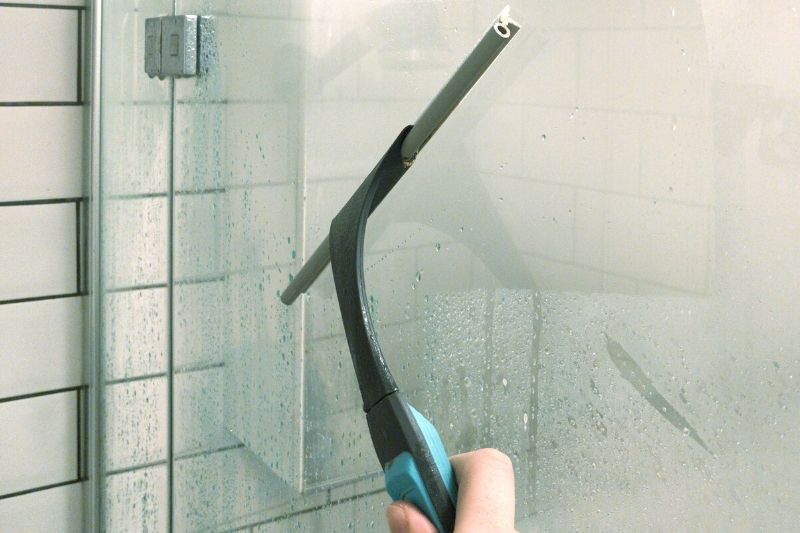
Keep a squeegee at hand
One way to prevent limescale build-up is to get rid of the moisture before it has time to evaporate, and an easy way to do this is with a squeegee.
Keep a squeegee close to your shower and other glass that is prone to limescale. When you finish in the shower, wipe the surfaces down with the squeegee as soon as possible.
What Is Limescale?
Limescale is the crusty, white, or green deposit that gets left behind in hard water areas. If you do live in a hardwater area, this limescale (or calcium carbonate) tends to stick to glass, tiles, and fixings as the water flows over them.
When the water evaporates, the limescale is left behind. Limescale can occur anywhere with a water supply, such as showers, dishwashers, kettles, washing machines, and pipes.
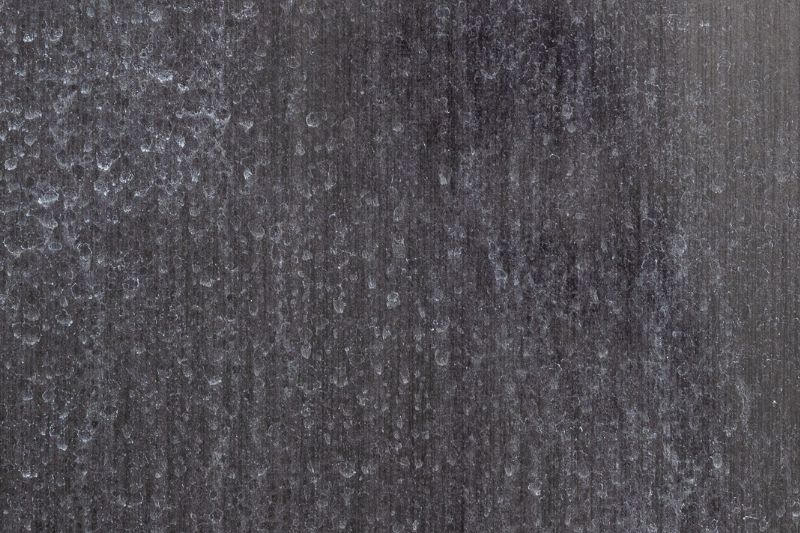
Why Is Limescale Bad?
The effects of limescale vary depending on where in your home the deposits have built up. On glass and other sturdy surfaces, such as tiles, it is simply unsightly.
However, if the limescale is in your shower, you might find that the shower head gets clogged up and needs harsh cleaning chemicals to clear it.
Limescale can also clog up household appliances and pipes, and if left for too long, this can cause corrosion in pipes, on kettle elements, the inside of washing machines and other such effects.

Lover of coffee, painting, and all things cute and fluffy. I’m always on the lookout for easier, more gentle ways to tackle awful household chores.


